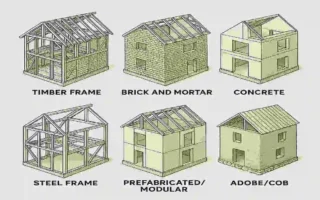Wood frame houses are a popular choice for many homeowners due to their affordability, sustainability, and energy efficiency. If you’re considering building a wood-frame house, one of the first questions you might ask is, “How long does a wood-frame house take to build?” Knowing the construction timeline is crucial for planning and budgeting purposes.
What Is a Wood Frame House?

A wood-frame house is a structure that uses wooden studs, joists, and rafters as its primary structural components. There are two main types of wood framing:
- Traditional stick framing: Each component is cut and assembled on-site.
- Prefabricated timber framing: Components are manufactured off-site and assembled on-site.
Wood frame houses offer several benefits, including:
- Affordability compared to other construction methods
- Sustainability, as wood is a renewable resource
- Energy efficiency when properly insulated
Typical Timeline for Building a Wood Frame House
On average, building a wood-frame house takes between 6 and 9 months from start to finish. However, this timeline can vary depending on various factors, which we’ll discuss later. Here’s a breakdown of the major phases:
- Design and planning phase: This can take anywhere from a few weeks to several months, depending on the complexity of the design and the permitting process.
- Foundation work: Once the design is finalized and permits are obtained, the foundation work typically takes 1 to 2 weeks to complete.
- Framing construction: The framing phase, which involves erecting the walls, floors, and roof skeleton, usually takes 1 to 3 weeks.
- Exterior and interior finishing: The remainder of the construction process, including installing utilities, insulation, drywall, and finishes, can take several months.
Detailed Look at the Framing Phase
The framing phase is a crucial step in constructing a wood-framed house. It involves creating the walls, floors, and roof skeleton, which will serve as the backbone of the structure. The duration of the framing phase can vary depending on the size and complexity of the house:
- Small homes (under 1,000 sq. ft.): Framing can be completed in as little as 2-3 days.
- Average homes (1,500-2,500 sq. ft.): Framing typically takes 1-3 weeks.
- Larger or more complex homes: Framing can take up to 3 weeks or more.
Several factors can affect the speed of the framing process, including:
- The skill and experience of the framing crew
- Weather conditions
- Availability of materials
Factors That Influence Construction Timeline

While the typical timeline for building a wood-frame house is 6 to 9 months, several factors can influence the overall duration:
- Size and complexity of the house design: Larger and more intricate designs will take longer to build.
- Weather conditions and seasonal impact: Inclement weather can cause delays, especially during the foundation and framing phases.
- Availability of materials and skilled labor: Supply chain issues or a shortage of skilled workers can slow down the construction process.
- Site accessibility and preparation: Difficult-to-access sites or those requiring extensive preparation will add to the timeline.
- Permits and inspections timeline: Delays in obtaining permits or scheduling inspections can hold up the construction process.
- Use of prefabricated panels vs. traditional framing: Prefabricated panels can speed up the framing process.
- Project management efficiency: Effective coordination and communication among the construction team can help keep the project on schedule.
Prefabricated Wood Frame Houses and Speed Advantages
Prefabricated timber frame construction involves manufacturing the structural components off-site in a controlled factory environment. These components are then transported to the building site and assembled quickly and efficiently. Prefabricated wood frame houses offer several advantages in terms of construction house speed:
- Shorter overall construction times, ranging from a few weeks to a couple of months
- Factory-controlled quality and rapid on-site assembly (e.g., framing can be completed in 3-4 days)
- Ideal for homeowners who want to minimize on-site construction time
Tips to Speed Up Building a Wood Frame House
If you’re looking to expedite the construction process for your wood frame house, consider these tips:
- Early and thorough planning and permits: Invest time in the design and planning phase to avoid delays later on.
- Choosing prefab or panelized options: Prefabricated components can significantly reduce on-site construction time.
- Hiring experienced contractors and framing crews: Skilled professionals can work more efficiently and quickly.
- Preparing the site and foundation in advance: Having the site ready before construction begins can save time and resources.
- Scheduling around weather considerations: Plan construction phases to minimize the impact of inclement weather.
Common Challenges That May Cause Delays
Despite careful planning, several challenges can arise during the construction process that may cause delays:
- Supply chain issues or backordered materials
- Weather interruptions
- Design changes mid-construction
- Labor shortages or crew changes
- Inspection hold-ups and permit delays
Cost Implications Related to Construction Time
The construction timeline can have a direct impact on the overall cost of building a wood-frame house:
- Longer timelines generally result in higher costs due to increased labor hours and potential material price fluctuations.
- Expedited work or overtime labor may come with a premium price tag.
- It’s essential to balance the desire for a speedy construction process with the need for quality artistry.




